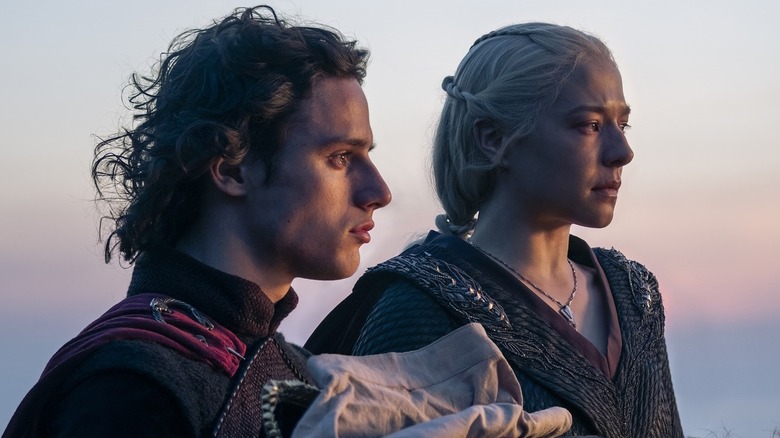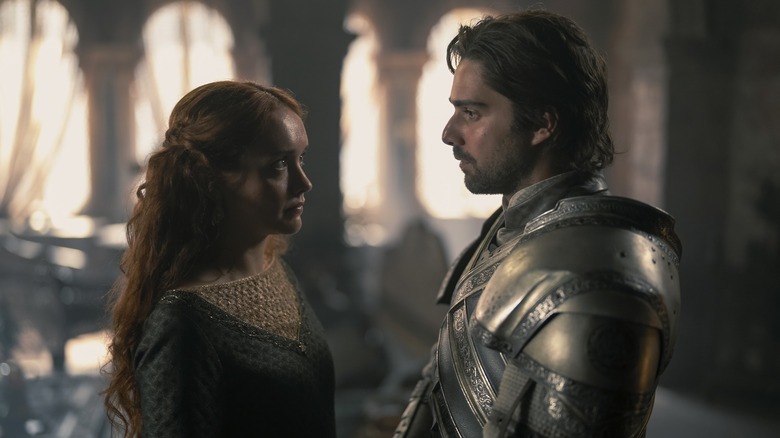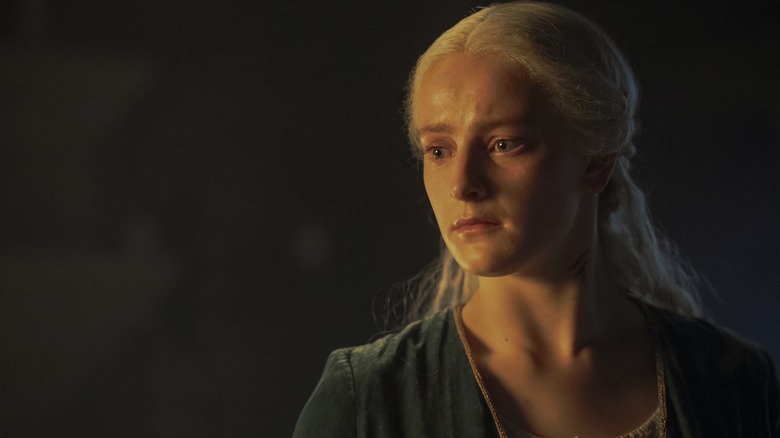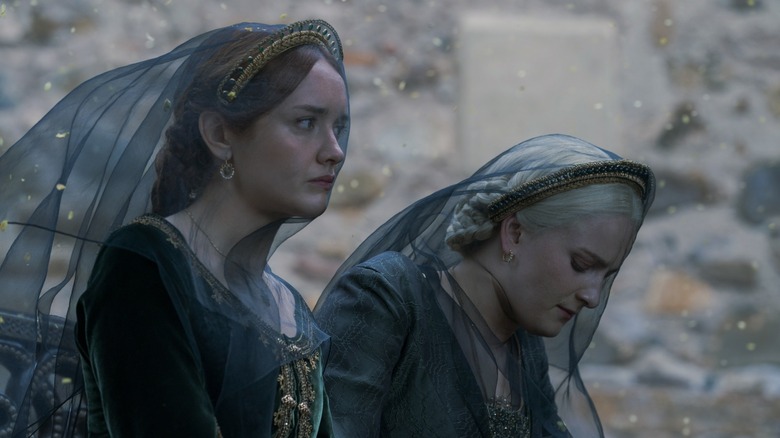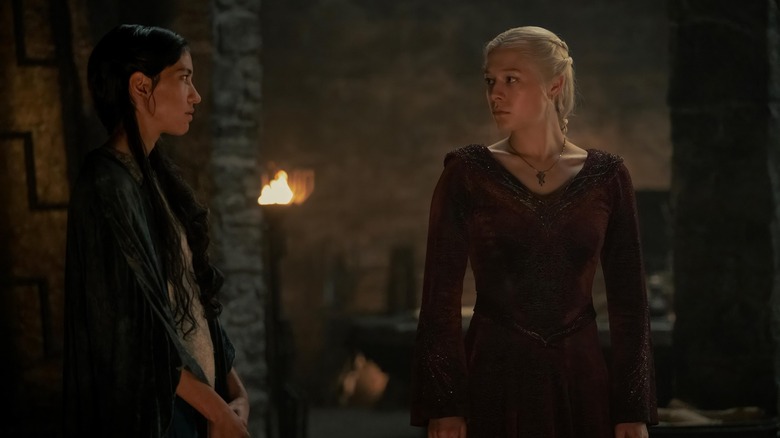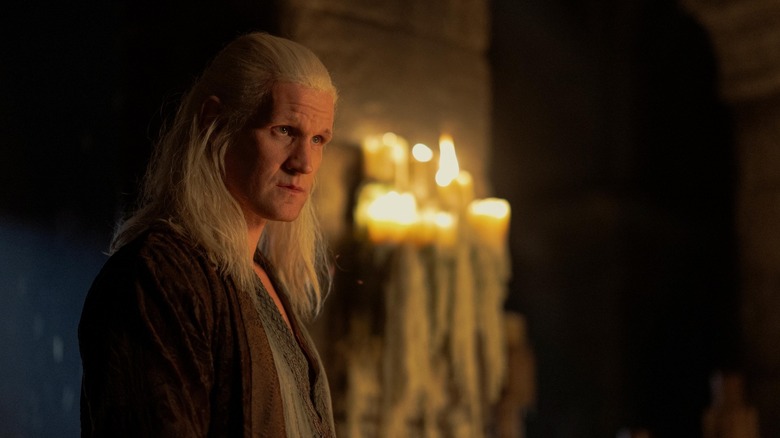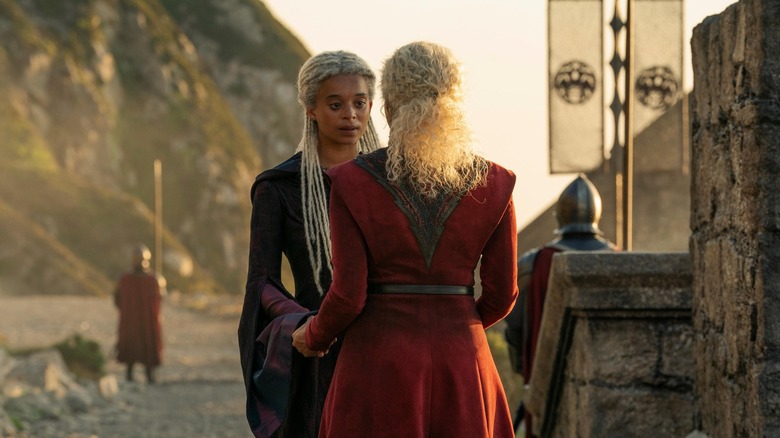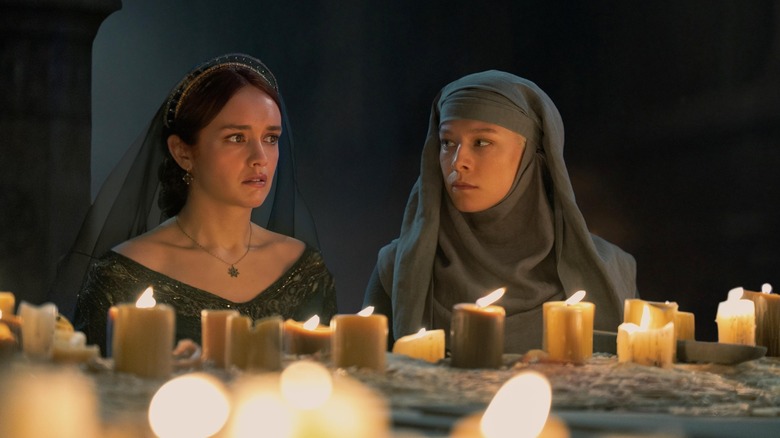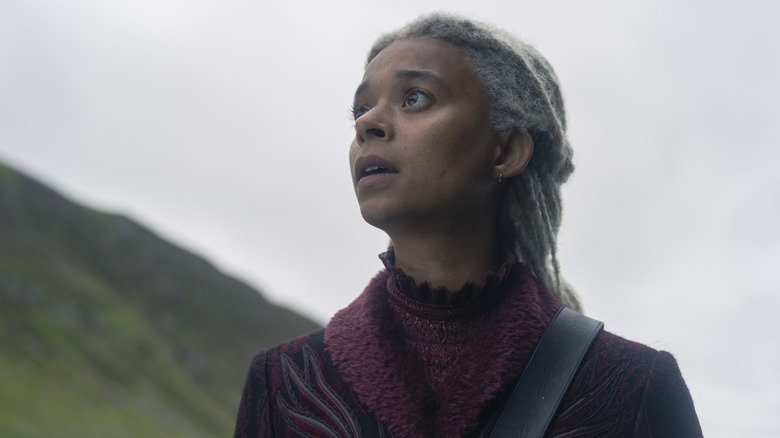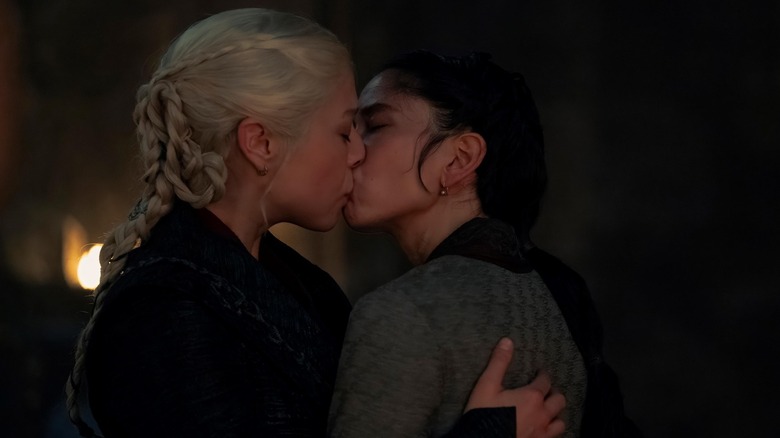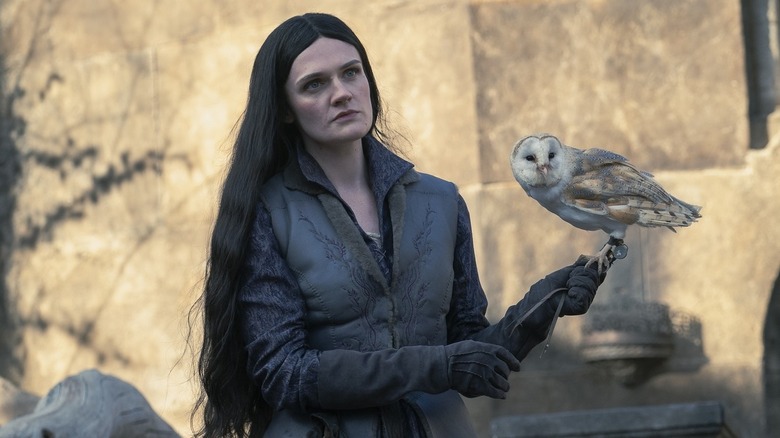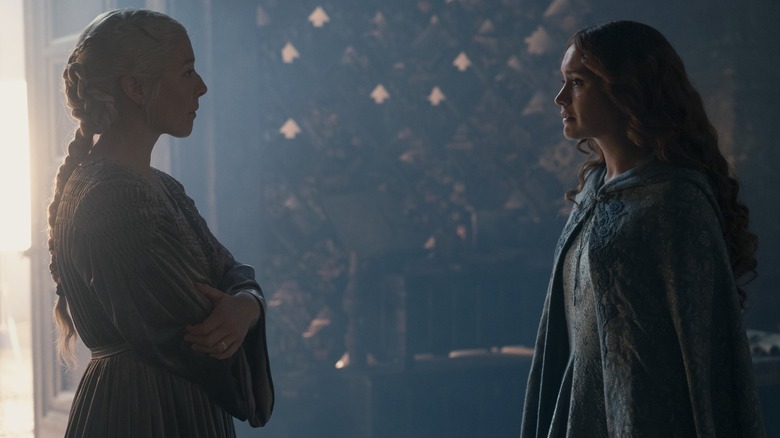Everything House Of The Dragon Season 2 Gets Wrong From Fire & Blood
Adapting any book into a television series is tricky; just look at what happened with "Game of Thrones," which ran out of steam in a big way after it had to deviate from George R.R. Martin's "A Song of Ice and Fire" series. That series ended in 2019 and the finale was met with some extremely blunt reactions from fans, but so far, the first spin-off and prequel, "House of the Dragon" — based on Martin's Targaryen family history "Fire & Blood" — is faring a bit better. That being said, the show, now spearheaded by "Game of Thrones" veteran Ryan Condal, is still making some big missteps as far as the book is concerned.
Of course, it's important to note that "Fire & Blood" reads more like an oral history than a traditional narrative like any of the books in "A Song of Ice and Fire," so it's definitely a little more complicated in terms of a true adaptation. Still, Condal and his team made some enormous adjustments in the show's sophomore season, which picks up just as the Targaryen civil war known as the Dance of the Dragons kicks off in earnest. From a steamy royal affair to two surprising reunions, here's everything major that "House of the Dragon" Season 2 adjusted in adapting "Fire & Blood."
Contains spoilers for "House of the Dragon" Season 2
Alicent Hightower's secret affair isn't in the source material
The relationship between Rhaenyra Targaryen and Alicent Hightower (played in the early Season 1 timeline by Milly Alcock and Emily Carey, respectively) is a complicated one. After a young Rhaenyra runs afoul of her best friend and stepmother Alicent for the former's one-night stand with Ser Criston Cole (Fabien Frankel), Alicent apparently takes a second look at the formidable knight. In the Season 2 premiere, "A Son for a Son," it's revealed that adult Alicent (Olivia Cooke), widowed after the death of her husband and Rhaenyra's (Emma D'Arcy) father King Viserys I Targaryen (Paddy Considine), is carrying on with Ser Criston herself, and the whole arrangement is clearly a closely-guarded secret.
Again, "Fire & Blood" doesn't delve into very many personal details; the tome is far more concerned with politics and the civil war at hand than any torrid royal dalliances. Still, it's notable that Ryan Condal and his creative team decided to add in a romance between Alicent and Ser Criston, particularly because it gives Ser Criston a reason to be completely occupied with Alicent while assassins attack the dowager queen's daughter and grandchildren in the royal stronghold.
The murder of Prince Jaehaerys is far worse in the book
One thing's for sure — the ending of "House of the Dragon" Season 2's premiere is much worse in the book. At the end of Season 1, Rhaenyra's second-eldest son Lucerys Velaryon (Elliot Grihault) is killed on dragonback by his uncle and Alicent s second-eldest son, Aemond Targaryen (Ewan Mitchell), leaving Rhaenyra desperate for revenge. She says as much to her husband Daemon Targaryen (Matt Smith), who decides to find some assassins within King's Landing but also doesn't give them any major specifics, apparently, apart from an order to kill a prince. The two killers — ratcatcher Cheese (Mark Stobbart) and swordsman Blood (Sam C. Wilson) — don't find Aemond, but they do find Alicent's daughter Helaena (Phia Saban) and her two young twins, Prince Jaehaerys and Princess Jaehaera.
In the episode's final moments, the murderers behead Prince Jaehaerys as Helaena runs from the room with her surviving child. If it felt brutal to watch this play out on "House of the Dragon," you may want to skip this part in "Fire & Blood." Blood and Cheese threaten to do unspeakable things to Jaehaera, and, though they make Helaena point out the young prince in the show, they force her to choose between her sons in the book. When she opts to sacrifice her younger son Maelor (who doesn't exist in the series), the murderers laugh at her and kill Jaehaerys. Also, it's worth noting that, in the book, the murder of Jaehaerys takes place in Alicent's bedroom — she's bound and gagged along with her maid. In the show, she's enjoying the company of Ser Criston Cole.
Helaena and Alicent never go on a macabre sympathy tour
After Helaena's son is killed in front of her, the young queen — who, it should be mentioned, is married to her own brother, King Aegon II Targaryen (Tom Glynn-Carney) — is left paralyzed by her own grief. Unfortunately for her, Alicent's father Otto Hightower (Rhys Ifans), who serves as Aegon's Hand of the King at this point in the narrative, wants to curry favor with the citizens of King's Landing, all of whom are distinctly feeling the effects of the royal family's war. The idea? Helaena and Alicent should parade through the Westerosi capital with a town crier yelling about how Rhaenyra is responsible for the death of Prince Jaehaerys.
It's a pretty ghastly attempt to paint Rhaenyra — who never intended for Helaena or her son to suffer, and who even tells Daemon that when she learns about the plot — as a murderer and gain sympathy for Alicent's Team Green in the process. It certainly heightens Helaena's suffering in the moment as she experiences what appears to be a major panic attack during the procession. Ultimately, it's a horrifying moment, but it does not appear anywhere in "Fire & Blood."
The show makes Mysaria a major player in Arryk versus Erryk
It's fair to say that Mysaria, the sex worker turned secret trader played onscreen by Sonoya Mizuno, is a much larger presence in "House of the Dragon" than she is in "Fire & Blood." Yes, George R.R. Martin makes passing mentions of the woman known as the White Worm, but in Season 2 of the HBO adaptation, Mysaria ends up joining Team Black and becomes an indispensable companion to Rhaenyra. How exactly does that happen? She rings the alarm regarding a plot to murder Rhaenyra, earning the queen's gratitude and allegiance; no such thing happens in "Fire & Blood."
Twins Erryk and Arryk Cargyll, played by real-life twins Elliott and Luke Tittensor, end up on opposite sides of the Dance of the Dragons throughout "House of the Dragon," with Arryk supporting Aegon's claim to the throne and Erryk standing by Viserys' original heir Rhaenyra. Since the twins are, in fact, identical, Ser Criston Cole seizes the opportunity and cooks up a scheme to send Arryk into Dragonstone posing as his own brother to kill the Black Queen, and the plan probably would have worked if Mysaria hadn't seen Arryk sneaking into Rhaenyra's stronghold. Apparently realizing Erryk was already in the castle, Mysaria is able to tell him that his twin is about to murder the queen, and Arryk and Erryk end up fighting to the death. That conflict does happen in the book, but Mysaria plays no role in it whatsoever.
Daemon's visions at Harrenhal only happen in the show
Throughout Season 2 of "House of the Dragon," Daemon ends up separated from his wife Rhaenyra and the entirety of Team Black thanks to his conquest of Harrenhal, an important location for the war geographically that also happens to be a drafty old castle that's falling apart. It's also, apparently, sort of haunted, judging by the fact that Daemon keeps experiencing bizarre visions during his time there.
Whether Daemon is talking to and beheading a younger version of Rhaenyra (played by a returning Milly Alcock, a pleasant surprise after her excellent performance in Season 1), having accidental sex dreams about his own mom, or seeing his dead brother, his visions are downright strange, and that's to say nothing of the long-form hallucination he sees during the Season 2 finale.
Encouraged to approach the castle's weirwood tree by Harrenhal's friendly in-house witch Alys Rivers (Gayle Rankin), Daemon sees iconic imagery familiar to fans of "Game of Thrones," including Daenerys Targaryen (Emilia Clarke) reborn from a fire with three baby dragons and the Night King alongside his army of undead ice zombies. Nowhere in "Fire & Blood" does Daemon experience visions of any kind, so all of these are an invention of the on-screen adaptation.
The whole thing with the dragon eggs is different in the book
In "Fire & Blood," Rhaenyra decides to send her stepdaughter Rhaena Targaryen (Phoebe Campbell) away from Dragonstone to keep some of the younger heirs to the throne safe during the war, and she sends three dragon eggs with the retinue. In "House of the Dragon," Rhaena and the young Targaryen princes leave with four eggs, three of which are actually a vital part of the "Game of Thrones" timeline.
As Geeta Patel — who directed "The Burning Mill," the episode that features the collection of dragon eggs — revealed, three of the eggs end up in the possession of Daenerys Targaryen, who helps said eggs hatch long after the events of "House of the Dragon" and many years after dragons are commonplace in Westeros. "Those are Daenerys' eggs," Patel confirmed to Mashable. "All of us who work on this show are big 'Game of Thrones' fans, so it was very exciting to shoot that scene."
Eagle-eyed fans noticed, during the scene where the eggs are clearly visible, that the colors even match up to Daenerys' dragons — red for Drogon, gold for Viserion, and green for Rhaegal — but this does mark yet another divergence from "Fire & Blood." In the book, Daenerys' dragon eggs take a different path, stolen and then sold by a sailor named Elissa Fairman who's in love with a different Rhaena Targaryen, but it's pretty cool that "House of the Dragon" ties the eggs to the original series.
The first reunion between Alicent and Rhaenyra doesn't actually happen in Fire & Blood
In "The Burning Mill," Rhaenyra makes a bold decision and secretly infiltrates King's Landing so that she can confront Alicent and try to convince the dowager queen to stop the senseless war. Dressed as a septa, Rhaenyra masks her identifiable white-blond Targaryen hair and intercepts Alicent while her stepmother and former friend prays in a sept — and though Rhaenyra is armed with a knife just to be safe, she means Alicent no harm.
As she begs Alicent to consider calling off her forces and finding a peaceful solution to the conflict that has killed Rhaenyra's son and Alicent's grandchild, she asks Alicent about Viserys' final moments and has a stunning realization: Alicent thought that the late king muttered "Aegon" in reference to their son, but Rhaenyra knows for a fact that her father was referencing the "song of ice and fire" predicted by their ancestor Aegon the Conqueror.
Alicent is unwilling to end the war, arguing that it's too late to find any sort of solution, and insists that Rhaenyra leave the city before she's detected. Olivia Cooke and Emma D'Arcy's chemistry is outstanding, and it's an excellent move by "House of the Dragon" to put them on-screen together even in the midst of a war where they're bitter enemies. Too bad this doesn't happen in "Fire & Blood;" Rhaenyra never sneaks into King's Landing, and the two never have this fraught chat.
Where's Nettles? This major book character may never appear in House of the Dragon
Throughout "House of the Dragon," Rhaena Targaryen often gets the short end of the stick — and a big part of that is the fact that she doesn't yet have a dragon. While her older sister Baela (Bethany Antonia) rides the powerful airborne steed Moondancer, Rhaena is dragonless and stuck taking care of Rhaenyra's youngest children. However, toward the end of Season 2, the tides turn as she realizes there's a dragon lurking nearby that keeps torching and snacking on sheep. In the season finale, "The Queen Who Ever Was," Rhaena takes control of her destiny and faces down the dragon, and it's easy to assume that, by Season 3, she'll be riding the wild, untamed dragon that "Fire & Blood" fans know as Sheepstealer.
Here's the problem: Sheepstealer is ridden by an entirely different character in "Fire & Blood," and it's very possible that Rhaena has simply replaced the fan-favorite known as Nettles. A canonical dragonseed (which refers to a bastard with ancient Valyrian blood) in the book, Nettles is a young woman of color who tames and rides Sheepstealer and, notably, goes on to have an affair with Daemon Targaryen. The show probably won't give Rhaena this particular plotline, considering that Daemon is her father. At this point, it seems as though Nettles simply won't appear in "House of the Dragon," and Rhaena is meant to take her place. It's understandable from a narrative point of view, but it's still a blow to fans of the character.
Mysaria and Rhaenyra's relationship never evolves
In the sixth episode of "House of the Dragon" Season 2, titled "Smallfolk," Rhaenyra and Mysaria share a surprising moment while alone in the queen's chambers. After they both confess their fears and trauma to each other (Mysaria shares details about the abuse she faced at her father's hands, and Rhaenyra reveals that she worries she can't win the familial war), they embrace and share a kiss. This means that, within the boundaries of the show, Rhaenyra and Mysaria are canonically queer — something "Fire & Blood" certainly never addresses — and it's also a major moment in the series that never appears in the source material.
As Sonoya Mizuno told Vulture after the episode aired, the moment wasn't planned from the start. "It wasn't scripted as a kiss," Mizuno said. "It was scripted as an intimate moment that got interrupted, and it was unknown where the scene was going to go. Emma [D'Arcy] and I both strongly felt that we didn't want it to be queer-baity in any way, and we wanted to step back, look at it, and take care of it. But it just felt right. It would be a kiss." Season 2 doesn't follow up on this development after "Smallfolk," but it could prove important further down the line — and it's definitely not taken from "Fire & Blood."
Alys Rivers' role is majorly expanded in House of the Dragon
Alys Rivers does appear in "Fire & Blood," but the version of the character seen in "House of the Dragon" (played by Gayle Rankin, in case you were wondering why Alys looks so familiar) bears very little resemblance to her book counterpart throughout Season 2. The book goes as far as to say that while Daemon is at Harrenhal, she makes herself scarce, and the prince wasn't really affected by her witchcraft: "Whatever her powers, it would seem Daemon Targaryen was immune to them, for little is heard of this supposed sorceress whilst the prince held Harrenhal." Later in the narrative, she ends up involved with Aemond Targaryen, who goes to bed with her despite their pretty notable age difference.
In "House of the Dragon," Daemon is very much not immune to Alys' powers. As previously stated, it's her sorcery that allows him to see visions of Daenerys Targaryen and the Night King at the weirwood tree. It's also implied that Alys is perhaps meddling with Daemon's food and drink, allowing him to freely experience visions while at Harrenhal. While she remained largely in the shadows in "Fire & Blood," that's definitely not the case on "House of the Dragon."
Alicent's deal with Rhaenyra is another major change
At the end of "The Queen Who Ever Was," it's Alicent's turn to sneak into the enemy's stronghold and try to reason with them. After getting kicked off the small council by her conniving son Aemond and spending some time communing with nature, she seeks out Rhaenyra to make a deal. Though Alicent tells her former friend that she'll convince a grievously injured Aegon to bend the knee, Rhaenyra counters, saying that the only possible solution is for Alicent to present her with Aegon's head and allow Rhaenyra to take the Iron Throne. In a stunning turn of events, Alicent agrees to behead her own son, telling Rhaenyra to come to King's Landing in a few days as a conqueror.
This entire scene — as well as the moment where Alicent asks Rhaenyra to run away with her, which left fans craving a romance — doesn't happen in "Fire & Blood." In fact, it's the total opposite. When Rhaenyra takes advantage of Aemond's absence and easily takes King's Landing, Alicent threatens her: "Bowing her head in defeat, Queen Alicent surrendered the keys to the castle and ordered her knights and men-at-arms to lay down their swords. 'The city is yours, Princess,' [Alicent] is reported to have said, 'but you will not hold it long. The rats play when the cat is gone, but my son Aemond will return with fire and blood.'" The shocking "House of the Dragon" Season 2 twist sets up a juicy conflict for Season 3, but you definitely won't find it anywhere in "Fire & Blood."
